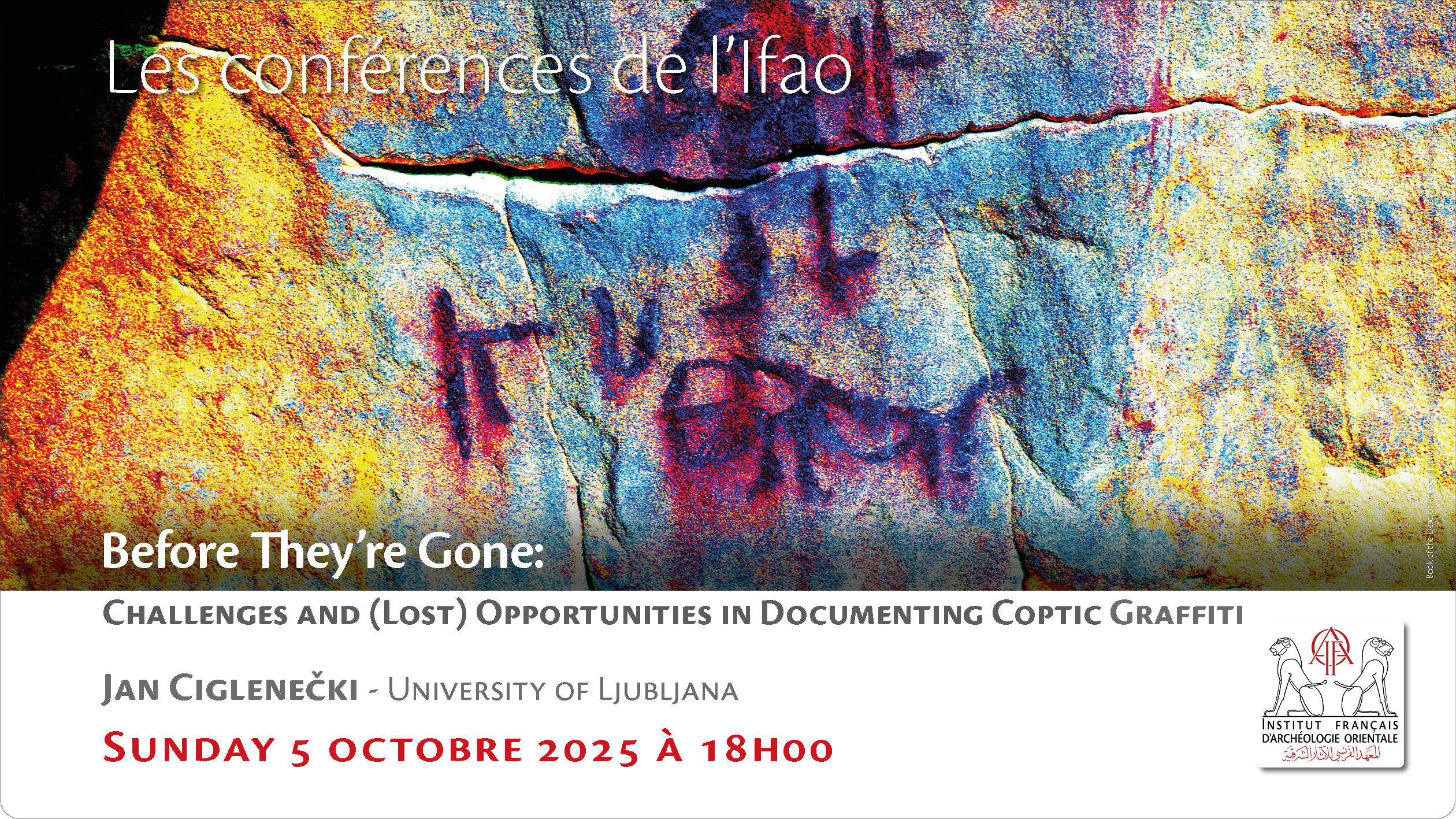Manifestations scientifiques
Abonnez-vous à la … Subscribe to the Mailing list :

Les conférences de l’Ifao
Le dimanche 5 octobre 2025 à 18h00 (heure du Caire), IFAO 
Before They’re Gone:
Challenges and (Lost) Opportunities in Documenting Coptic Graffiti
Jan Ciglenečki
Langue : anglais.
In the framework of Workshop Papyrology in Dialogue, organized jointely by the Institut français d’archéologie orientale (Ifao)and the Center for Middle Eastern Studies, Faculty of Arts, University of Ljubljana, Slovenia, Dr. Jan Ciglenečki will give a Keynote lecture, Sunday 5 october 2025 at 6 P.M. at the Ifao.
The lecture is public, and free to attend within the limit of available places in the Ifao conference room. Please note that entrance will not be allowed once the room has reached its maximum capacity, and in all cases 15 minutes after the beginning of the lecture. Thank you for your understanding.
Abstract
The widespread presence of Coptic graffiti and dipinti on monastic sites across Egypt offer valuable yet fragile insights into the country's Christian past. While interest in these often naïve, yet deeply genuine expressions of faith is growing, their documentation remains fraught with challenges. The first significant wave of graffiti recording occurred in the mid-20th century, a period when Coptic archaeology gradually began to emerge from the shadow of Egyptology, gaining momentum after decades of neglect in favor of the monuments of the pharaonic past. During this time, scholars (often not formally trained in archaeology) were able to access numerous Coptic monastic sites with relative freedom, particularly in Middle Egypt, where Late Antique monastic communities had reoccupied earlier dynastic tombs. The development of photography during this period allowed for the documentation of many Coptic graffiti for the first time, creating an invaluable record of what was still extant at the time. These early photographs now serve as critical reference points, enabling comparison with the current condition of the sites and illustrating the extent of deterioration over the decades. However, the limitations of analog photography meant that numerous inscriptions, particularly faint or marginal ones located in poorly lit or subterranean spaces, escaped documentation, primarily due to the high cost of film and the technical challenges of operating photographic equipment under such conditions.
The situation changed radically with the digital revolution of the 21st century. Modern photography now offers unprecedented tools: high-resolution imaging, digital enhancement, and non-invasive survey techniques make it possible to detect even faint or heavily weathered inscriptions. Nevertheless, we find ourselves in a paradoxical situation. Despite the availability of advanced documentation technologies, changes in access policies over the past three decades have made many archaeological sites less accessible, leaving exposed graffiti vulnerable to rapid deterioration from environmental factors, vandalism, and looting. This talk reflects on the methodological, logistical, and ethical dimensions of documenting Coptic graffiti under current constraints. It highlights the urgent need for closer collaboration between domestic and foreign archaeological missions and dedicated documentation initiatives that address Coptic heritage specifically. One such initiative is the Coptic Monastic Heritage Archive, housed at the University of Ljubljana. Since 2014, coinciding with the rise of digital photography, it has focused on documenting endangered monastic sites across Egypt and integrating this material into what is today likely the largest unified photographic repository of Coptic monastic heritage.
 Dr. Jan Ciglenečki holds a permanent position at the Department of Philosophy, Faculty of Arts, University of Ljubljana, where he lectures on Ancient Greek and Medieval philosophy, with a particular research focus on the Coptic monasticism. In 2024, he co-founded the Center for Middle Eastern Studies at the Faculty of Arts and leads its Section for Egyptology and Coptology. During his one year study visit to Cairo in 2014, he started to document monastic sites across Egypt, which in 2018 developed into a project »Endangered Hermitages: Documenting Coptic Monastic Heritage in Middle Egypt and in the Eastern Desert (funded by ARCE)«. He participated in the Dutch-Flemish archaeological mission at Deir el-Barsha (2019) and the French archaeological mission at Wadi el-Jarf (2021). In 2024, the initial photo archive compiled during the first ten years of his fieldwork in Egypt was incorporated into the Coptic Monastic Heritage Archive, housed at the Faculty of Arts, University of Ljubljana. In 2024, the Coptic Monastic Heritage Archive began a close collaboration with the Endangered Archaeology in the Middle East and North Africa (EAMENA) project to integrate Coptic heritage data into their database.
Dr. Jan Ciglenečki holds a permanent position at the Department of Philosophy, Faculty of Arts, University of Ljubljana, where he lectures on Ancient Greek and Medieval philosophy, with a particular research focus on the Coptic monasticism. In 2024, he co-founded the Center for Middle Eastern Studies at the Faculty of Arts and leads its Section for Egyptology and Coptology. During his one year study visit to Cairo in 2014, he started to document monastic sites across Egypt, which in 2018 developed into a project »Endangered Hermitages: Documenting Coptic Monastic Heritage in Middle Egypt and in the Eastern Desert (funded by ARCE)«. He participated in the Dutch-Flemish archaeological mission at Deir el-Barsha (2019) and the French archaeological mission at Wadi el-Jarf (2021). In 2024, the initial photo archive compiled during the first ten years of his fieldwork in Egypt was incorporated into the Coptic Monastic Heritage Archive, housed at the Faculty of Arts, University of Ljubljana. In 2024, the Coptic Monastic Heritage Archive began a close collaboration with the Endangered Archaeology in the Middle East and North Africa (EAMENA) project to integrate Coptic heritage data into their database.
Les conférences de l’Ifao
Les conférences de l'Ifao ont pour objectif la transmission des résultats des recherches en cours ou très récentes, par des chercheurs confirmés. Y sont conviés essentiellement les chercheurs impliqués dans les différentes opérations scientifiques de l'Ifao lors de leur passage par l'Institut. ِElles sont également parfois le lieu de présentation d'ouvrages récemment parus à l'Ifao par leurs autheurs. Les conférences de l'Ifao ont lieu traditionnellement les mercredis aprés-midis, en français ou en anglais.
IFAO Lectures series aim to transmit the results of current or very recent research by confirmed researchers. They are mainly animated by researchers involved in IFAO's various scientific programs and projects during their stay at the Institute. They are also sometimes the occasion for presentations, by their authors, of books recently published by the IFAO.
IFAO Lectures series are traditionally held on Wednesday afternoons, in French or English.

